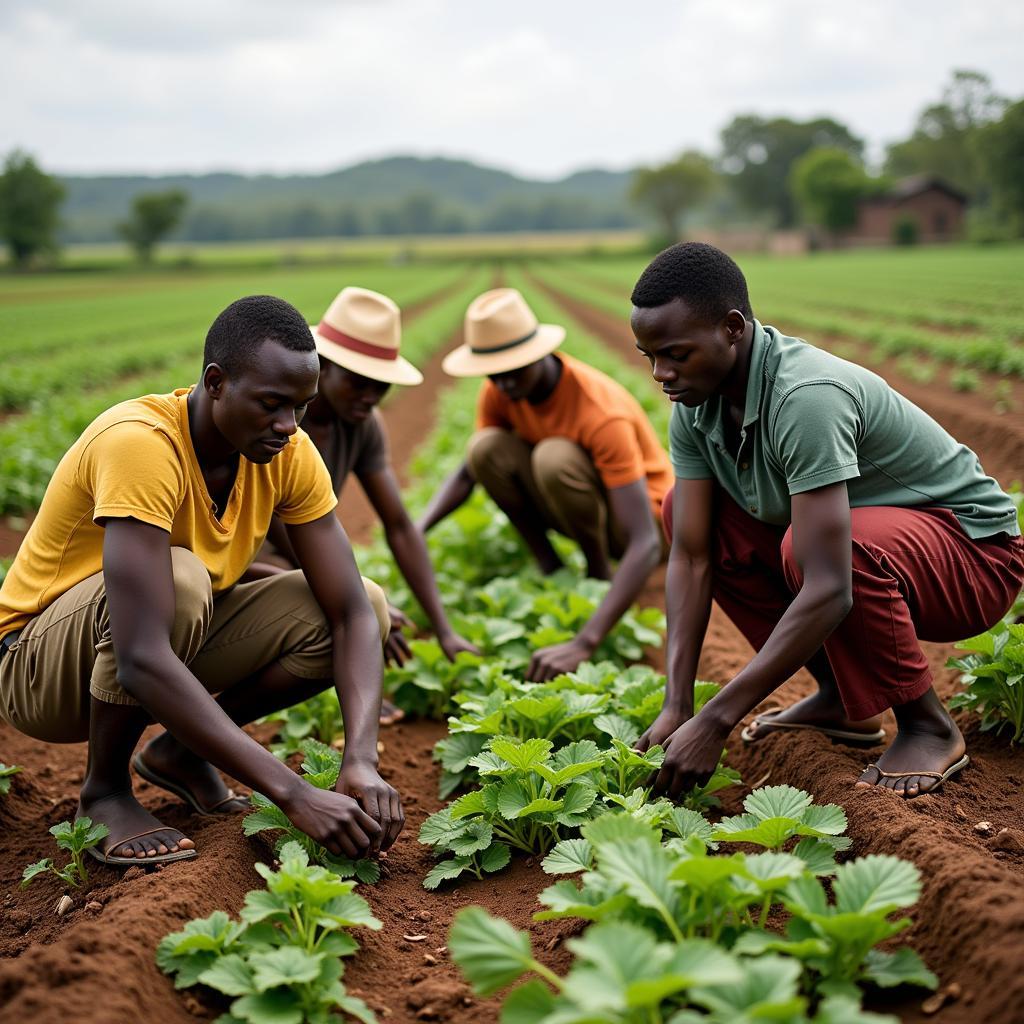The Haunting Image of African Children Starving Vulture
The iconic and disturbing photograph of a starving Sudanese child being stalked by a vulture, taken by Kevin Carter in 1993, became a symbol of famine and suffering in Africa. The “African Children Starving Vulture” image sparked widespread outrage and debate about the role of journalism, ethics, and the complexities of aid in a continent grappling with poverty and conflict. This article delves into the story behind the photograph, its impact, and the broader issues it raises about representing suffering in Africa.
Understanding the Context of “African Children Starving Vulture”
The photograph, taken during the 1993 famine in South Sudan, depicts a young, emaciated child collapsed on the ground, struggling to reach a United Nations feeding center. Looming in the background is a vulture, seemingly waiting for the child’s inevitable demise. The image immediately became a symbol of the devastating famine and the desperate plight of vulnerable children. It won the Pulitzer Prize, solidifying its place in history. But the photograph also sparked controversy. Many questioned Carter’s decision to photograph the scene instead of intervening. This fueled a discussion about journalistic ethics and the responsibility of photojournalists in documenting human suffering.
The Impact of the “African Children Starving Vulture” Image
The “african children starving vulture” photograph had a profound impact globally, raising awareness about the famine in Sudan and prompting international aid efforts. The image became a powerful fundraising tool for humanitarian organizations. However, it also faced criticism for its perceived exploitation of suffering. Some argued that the photograph reduced the child to a symbol, dehumanizing their experience and perpetuating negative stereotypes about Africa. The controversy surrounding the image highlighted the ethical dilemmas faced by photojournalists working in conflict zones and disaster areas.
Beyond the Single Frame: Addressing the Root Causes
The “african children starving vulture” image, while powerful, represents only a single moment in a complex and multifaceted crisis. To truly understand and address the issue of hunger in Africa, it’s crucial to look beyond the image and examine the underlying causes. These include political instability, conflict, climate change, poverty, and lack of access to resources.
The Role of Aid and Development in Combating Hunger
International aid and development efforts play a vital role in mitigating the effects of famine and addressing long-term food security challenges. However, it’s essential to ensure that aid is delivered effectively and sustainably, empowering local communities and addressing the root causes of hunger.
Long-Term Solutions for Food Security in Africa
Achieving long-term food security in Africa requires a multi-pronged approach that addresses both immediate needs and underlying structural issues. This includes investing in sustainable agriculture, improving infrastructure, promoting education and economic development, and addressing conflict and political instability.
Empowering Communities to Achieve Self-Sufficiency
Empowering local communities is crucial for achieving sustainable food security. This involves supporting local farmers, promoting access to education and healthcare, and fostering economic opportunities.
A fictional expert, Dr. Aminata Diallo, a renowned sociologist specializing in African development, emphasizes this point: “Sustainable solutions must prioritize community empowerment and local ownership. We need to move beyond short-term aid and focus on building long-term resilience.”
 African farmers working together in a field
African farmers working together in a field
Conclusion: From Image to Action – Addressing African Children Starving
The “african children starving vulture” image serves as a stark reminder of the devastating impact of hunger and the need for effective and sustainable solutions. While the photograph captures a moment of profound suffering, it also offers an opportunity to learn, to act, and to work towards a future where such images are no longer a reality. We must move beyond the shock and sadness and commit to addressing the root causes of hunger in Africa.
Dr. Diallo adds: “The image should not be viewed in isolation but as a call to action. We must remember that behind every statistic, there is a human story.” Another expert, Professor Kwame Nkrumah, an agricultural economist, states: “Investing in sustainable agriculture and empowering local farmers is not just about food security; it’s about building a more resilient and prosperous future for Africa.”
FAQ
- What is the story behind the “african children starving vulture” photo? The photo depicts a starving child during the 1993 famine in Sudan, stalked by a vulture.
- Who took the photograph? Kevin Carter.
- Why was the photo controversial? It raised ethical questions about the photographer’s role and the exploitation of suffering.
- What impact did the photo have? It raised awareness and prompted aid, but also sparked criticism.
- How can we help address hunger in Africa? By supporting aid organizations, advocating for policy changes, and promoting sustainable development.
- What are the root causes of hunger in Africa? Conflict, poverty, climate change, and lack of access to resources.
- How can we achieve long-term food security in Africa? Through sustainable agriculture, infrastructure development, education, and addressing political instability.
Need support? Contact us 24/7:
Phone: +255768904061
Email: [email protected]
Address: Mbarali DC Mawindi, Kangaga, Tanzania.
You might also be interested in these other articles on our website:
- The impact of climate change on food security in Africa
- The role of education in empowering African communities
- Stories of resilience and hope from across Africa
We encourage you to explore these resources and learn more about the diverse cultures and challenges facing the continent.


